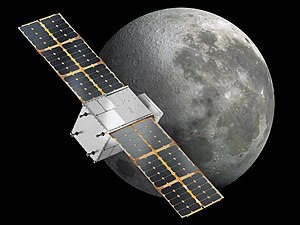Capstone
| Capstone | |
|---|---|

|
|
| Country: |
|
| Operator: | NASA |
| Mission dates | |
| Dimensions: | 25 kg |
| Size: | 22.6 × 22.6 × 34 cm (without solar modules ) |
| Begin: | Early 2021 |
| Starting place: | MARS LC-2 |
| Launcher: | Electron / photon |
| Status: | planned |
| Orbit data | |
| Orbit: | near rectilinear halo orbit around the moon |
| Track height: | 1,500 - 70,000 km |
Capstone (short for Cislunar Autonomous Positioning System Technology Operations and Navigation Experiment ) is a planned small satellite and lunar orbit of NASA . The satellite is scheduled to be launched on its way to the moon in early 2021. Its task is to test a navigation method in cislunar space - the area between the moon and the earth. He will also test a new type of orbit around the moon before the space station Lunar Orbital Platform-Gateway (LOP-G) is stationed there.
satellite
Capstone is a 25 kg Cubesat in 12U format, which means that its dimensions are around 22.6 × 22.6 × 34 cm in transport. It has two solar modules for power supply , which are folded out after starting. The satellite costs 13.7 million US dollars and is being built by the California company Tyvak Nano-Satellite Systems . The company Advanced Space in Colorado is the general contractor for the project and provides individual modules such as the navigation system.
In addition to the systems required to achieve the mission objectives described below, the satellite also has a camera.
Orbit and Mission Objectives
For the LOP-G, an orbit of the type "almost rectilinear halo orbit " was chosen. In contrast to orbits close to the equator, such as those used for the Apollo missions , this Halo orbit enables constant visual or radio contact with the earth. It is also suitable as a starting point for moon landings in very different latitudes . According to calculations, the orbit is particularly stable under these specifications, so that little fuel is required for orbit corrections. The Capstone mission is intended to test these theoretical assumptions.
Another task of the satellite is to test an indirect navigation method : Capstone is to determine its position relative to the lunar satellite Lunar Reconnaissance Orbiter , which in turn navigates with the support of earth stations.
In addition, NASA named the gain of knowledge about as mission goals
- the approach of the almost rectilinear halo orbit from a highly efficient transfer orbit,
- the start of the moon with a Ride Share -Flight or a small rocket and
- the use of commercial space services for mission planning and the quick launch of a deep space cubesat.
Mission course (planned)
Capstone is scheduled to be launched on a small electron rocket from the Mid-Atlantic Regional Spaceport in early 2021 . The rocket is the satellite along with a photon - space tug into a low Earth orbit from; Photon then carries it on into a transfer orbit to the moon. From there, Capstone is expected to fly to Halo orbit on its own within three months. NASA set the duration of the subsequent main mission at half a year.
Individual evidence
- ↑ a b c d Stephen Clark: NASA to fly CubeSat pathfinder for gateway in unique lunar orbit . Spaceflight Now, September 26, 2019.
- ↑ a b c Stephen Clark: NASA picks Rocket Lab to launch lunar CubeSat mission . Spaceflight Now, February 15, 2020.
- ↑ a b c NASA Funds CubeSat Pathfinder Mission to Unique Lunar Orbit . NASA press release dated September 13, 2019.
- ^ A b Jeff Foust: NASA cubesat to test lunar gateway orbit . Spacenews, September 16, 2019.